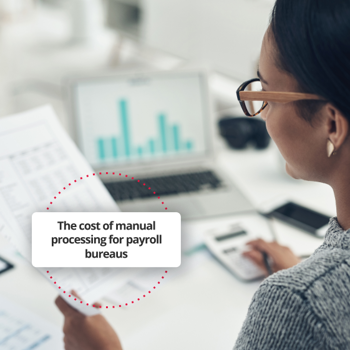
What is manual payroll processing?
Manual payroll processing refers to calculating wages, deductions, taxes and other payroll elements without the use of automated software. This usually involves spreadsheets, paper timesheets, email chains and repetitive data entry tasks.
For those offering payroll bureau services, sticking with manual methods may feel safe but it can introduce a host of risks that could be costly. Manual data transfer between systems, reliance on individual employees for accuracy, and limited data traceability all contribute to higher long-term costs. The lack of streamlined workflows also means longer turnaround times and greater administrative overheads, impacting your payroll bureau service costs.
What are the costs of manual processing for payroll bureaus?
With payroll bureau costs in the UK rising year-on-year, relying on outdated systems puts firms at a disadvantage. Manual processing affects both direct and indirect expenses, making your payroll process more expensive than it needs to be while also compromising on speed and accuracy. From human error and inefficient workflows to compliance pitfalls, the financial implications are wider than many realise. Every small inefficiency adds up, and can lead to lost clients, reputational damage and spiralling operational costs.
Payroll errors
Payroll errors are one of the most immediate and visible costs. Incorrect payments, miscalculated tax deductions and missed benefits are not only frustrating for employees but can also lead to regulatory penalties, reputational damage and time spent resolving mistakes. These issues are often caused by manual data entry, where even a small typo can lead to hours of corrective work.
Incorrect employee time tracking
Another common payroll mistake caused by manual processing is incorrectly tracking employee hours. Using emailed spreadsheets or paper forms increases the risk of data entry errors, particularly for shift-based roles or hourly staff. These discrepancies can lead to overpayments or underpayments, damaging relationships with clients and potentially leading to fines from HMRC.
Time-consuming tasks
Manually processing payroll involves chasing timesheets, entering data into spreadsheets, calculating deductions, double-checking entries, generating payslips, filing reports… the list goes on. Each step introduces the potential for delay and error, while also consuming valuable staff time. As volumes grow, so does the pressure on teams, making improving your payroll process an essential task to increase efficiency.
Compliance risks
Keeping up with changing tax codes, employment legislation and pension regulations is one of the biggest payroll challenges for SMEs. It’s hard enough with automated tools, so trying to do it manually is a serious gamble. Missed deadlines, outdated calculations and incomplete reporting can result in fines and employee frustration.
How can software reduce payroll bureau service costs?
For those offering payroll bureau services, technology helps to enhance service quality while keeping costs under control. Here’s how automation can reduce payroll bureau service costs across the board.
Reduces the risk of data entry errors
Manual data entry is a breeding ground for mistakes. Automating the input and transfer of data between systems ensures that information flows seamlessly from HR platforms to payroll software. This cuts down on work, prevents costly errors, and supports data integrity, making payroll software a much more reliable solution than using spreadsheets.
Increases timesheet accuracy
Digital timesheet systems make it easy for employees to log their hours in real time with automated approvals and validations. This helps to eliminate discrepancies and gives payroll teams cleaner, more reliable data to work with. By tracking employee hours using software rather than spreadsheets, bureaus can ensure accurate pay and increase client trust.
Saves time spent on manual processes
Workflow automation significantly reduces the time spent on repetitive, low-value tasks. From generating payslips to filing RTI submissions, workflows that once took hours can now take minutes. Your teams can then focus on client service, strategy or business development, giving your bureau a competitive edge without inflating operational costs.
Supports compliance tasks
With built-in alerts, legislative updates and automated reporting, the right software makes your payroll compliance checklist a breeze. By ensuring that submissions are filed correctly and on time, deductions are accurate, and audit trails are maintained, it reduces the risk of non-compliance and enhances client confidence.
Reduce your payroll bureau service costs with PeopleHR
From preventable errors and lost time to compliance headaches and dissatisfied clients, manual payroll processing carries a hidden price tag. These costs quickly add up, especially for bureaus managing multiple payrolls and rising payroll bureau costs in the UK. Investing in automation not only cuts payroll bureau service costs, but also helps you to boost service quality, scalability and profitability.
At PeopleHR, we help bureaus to reduce the time and cost of payroll through intuitive, integrated tools. Our cloud-based payroll software is designed to streamline your operations, improve accuracy, and support compliance with ease. To see how we can support your payroll bureau services, book a demo or contact our team and we’ll be happy to help.
